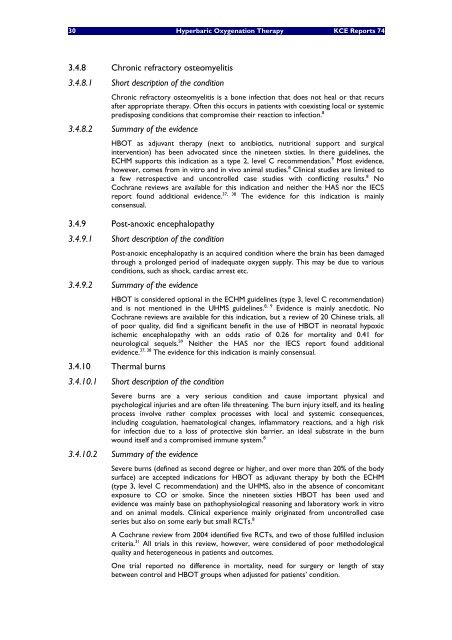Hyperbare Zuurstoftherapie: Rapid Assessment - KCE
Hyperbare Zuurstoftherapie: Rapid Assessment - KCE
Hyperbare Zuurstoftherapie: Rapid Assessment - KCE
You also want an ePaper? Increase the reach of your titles
YUMPU automatically turns print PDFs into web optimized ePapers that Google loves.
30 Hyperbaric Oxygenation Therapy <strong>KCE</strong> Reports 74<br />
3.4.8 Chronic refractory osteomyelitis<br />
3.4.8.1 Short description of the condition<br />
Chronic refractory osteomyelitis is a bone infection that does not heal or that recurs<br />
after appropriate therapy. Often this occurs in patients with coexisting local or systemic<br />
predisposing conditions that compromise their reaction to infection. 8<br />
3.4.8.2 Summary of the evidence<br />
HBOT as adjuvant therapy (next to antibiotics, nutritional support and surgical<br />
intervention) has been advocated since the nineteen sixties. In there guidelines, the<br />
ECHM supports this indication as a type 2, level C recommendation. 9 Most evidence,<br />
however, comes from in vitro and in vivo animal studies. 8 Clinical studies are limited to<br />
a few retrospective and uncontrolled case studies with conflicting results. 8 No<br />
Cochrane reviews are available for this indication and neither the HAS nor the IECS<br />
report found additional evidence. 37, 38 The evidence for this indication is mainly<br />
consensual.<br />
3.4.9 Post-anoxic encephalopathy<br />
3.4.9.1 Short description of the condition<br />
Post-anoxic encephalopathy is an acquired condition where the brain has been damaged<br />
through a prolonged period of inadequate oxygen supply. This may be due to various<br />
conditions, such as shock, cardiac arrest etc.<br />
3.4.9.2 Summary of the evidence<br />
HBOT is considered optional in the ECHM guidelines (type 3, level C recommendation)<br />
and is not mentioned in the UHMS guidelines. 8, 9 Evidence is mainly anecdotic. No<br />
Cochrane reviews are available for this indication, but a review of 20 Chinese trials, all<br />
of poor quality, did find a significant benefit in the use of HBOT in neonatal hypoxic<br />
ischemic encephalopathy with an odds ratio of 0.26 for mortality and 0.41 for<br />
neurological sequels. 59 Neither the HAS nor the IECS report found additional<br />
evidence. 37, 38 The evidence for this indication is mainly consensual.<br />
3.4.10 Thermal burns<br />
3.4.10.1 Short description of the condition<br />
Severe burns are a very serious condition and cause important physical and<br />
psychological injuries and are often life threatening. The burn injury itself, and its healing<br />
process involve rather complex processes with local and systemic consequences,<br />
including coagulation, haematological changes, inflammatory reactions, and a high risk<br />
for infection due to a loss of protective skin barrier, an ideal substrate in the burn<br />
wound itself and a compromised immune system. 8<br />
3.4.10.2 Summary of the evidence<br />
Severe burns (defined as second degree or higher, and over more than 20% of the body<br />
surface) are accepted indications for HBOT as adjuvant therapy by both the ECHM<br />
(type 3, level C recommendation) and the UHMS, also in the absence of concomitant<br />
exposure to CO or smoke. Since the nineteen sixties HBOT has been used and<br />
evidence was mainly base on pathophysiological reasoning and laboratory work in vitro<br />
and on animal models. Clinical experience mainly originated from uncontrolled case<br />
series but also on some early but small RCTs. 8<br />
A Cochrane review from 2004 identified five RCTs, and two of those fulfilled inclusion<br />
criteria. 31 All trials in this review, however, were considered of poor methodological<br />
quality and heterogeneous in patients and outcomes.<br />
One trial reported no difference in mortality, need for surgery or length of stay<br />
between control and HBOT groups when adjusted for patients’ condition.

















